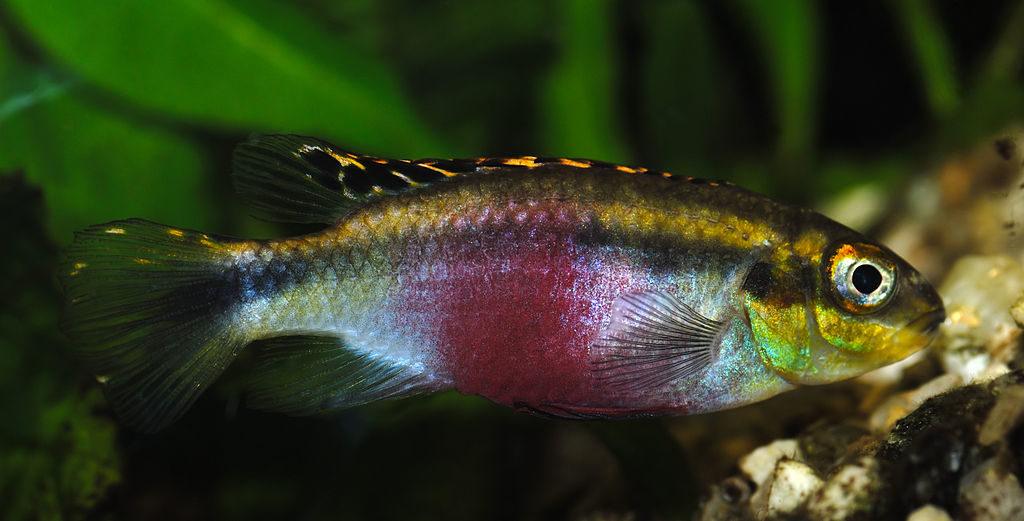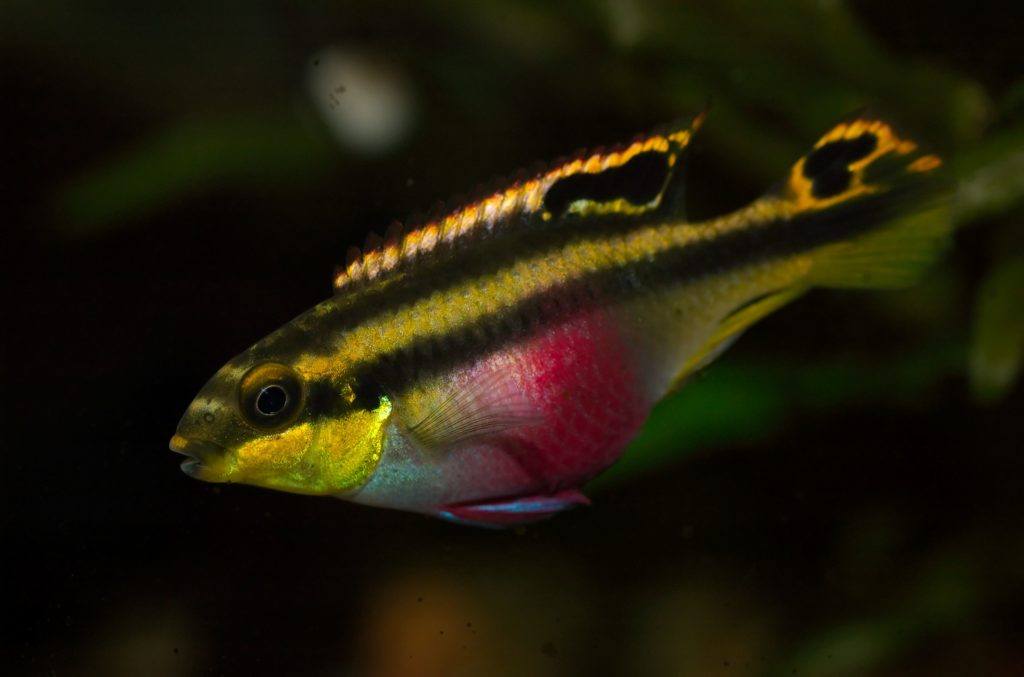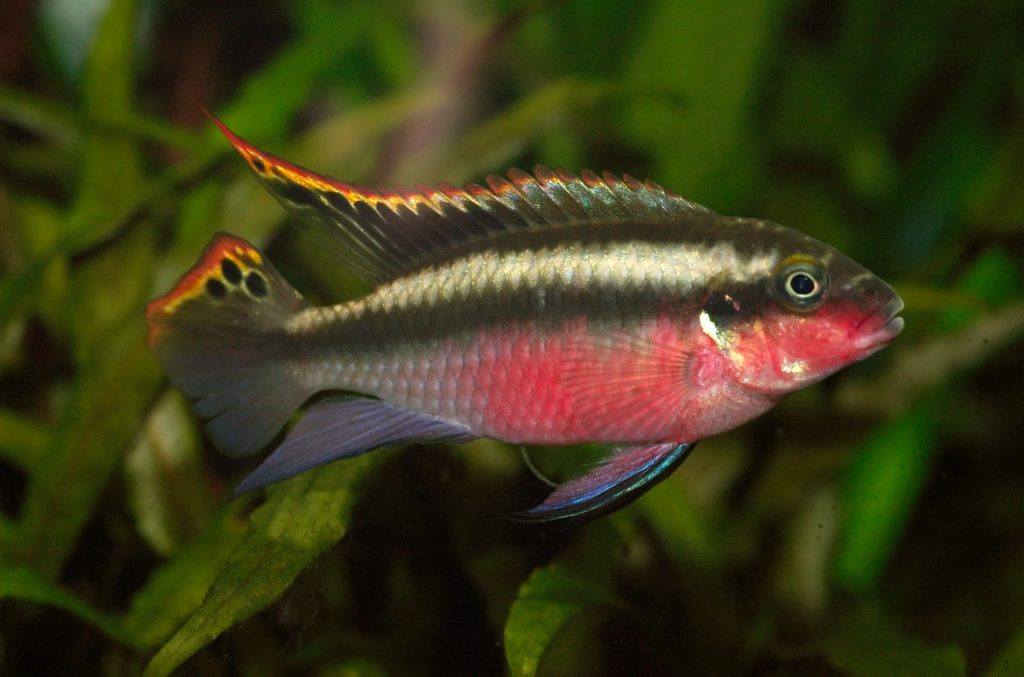The Kribensis cichlid, also known as the krib cichlid, is a favorite among beginning aquarists. They are both hardy and beautiful, two qualities that beginners seek.
They are a flexible fish, able to adapt to most aquarium conditions, and their lovely colors provide great flare to nearly any tank set-up.

Contents
The Krib Cichlid
Appearance
Colloquially, the term kribensis is used as a catch-all phrase to refer to seven species of the genus Pelvicachromis.
Technically, the kribensis only refers to the one Pelvicachromis species, Pelvicachromis taeniatus. However, in aquarist circles, the kribensis refers to Pelvicachromis pulcher, or P. pulcher. P. pulcher can also be called the Palette cichlid, or the Rainbow krib.
Its alternative name refers to its colorful appearance: a body made of a myriad of colors, with pointed trailing fins.
When spawning, their colors become even brighter; the females display a bright red spot just below their jaws, signaling that they are ready to mate.
The coats of both males and females display more color, to entice the other sex into mating.
Natural Habitat
The kribensis fish is indigenous to Africa, specifically in Nigerian rivers.
The common kribensis varieties, which are found in shops, are native to different rivers, and this has led to a large variety in what we now know as ‘kribensis fish.’
The kribensis is often found in freshwater rivers. A number of sources indicate that they are commonly found in brackish waters, but this has been a cause of debate.
Despite this debate, you can rest assured that the kribensis is commonly found in shallow rivers, since shallow waters are a way to avoid predators, allowing more eggs to survive into adulthood.
Caring for Your Kribensis

Tank and Water Requirements
Because of their adaptability, cichlids can be kept in most tank conditions. Kribensis thrive on conditions that mimic their natural habitat, and thus, it would be wise to imitate a freshwater river.
Specifically, acidity should be neutral to slightly acidic, about 5.5 to 7, with a hardness of about 8-12 dGH. The temperature should be kept around 76 degrees Fahrenheit.
To ensure that your kribensis enjoys in the best conditions, you may want to figure out the conditions in which your kribensis was raised. You can do this by asking the pet store, private seller, or online vendor from whom you bought your fish.
Barring this, the best you can do is avoid sudden changes to water conditions that would unnecessarily stress your kribensis. Should changing the water conditions be necessary, be sure to introduce the change gradually, so your fish have time to adjust.
Tank Set-Up
As for aquarium décor, it is still a good idea to mimic that of a freshwater river.
Due to rushing water, you would not see fine debris in a freshwater river. Decor should be kept to rocks, large mulch, and lots of plants.
Also be sure to provide your kribensis with a nook to hide in. This can be something as simple as a pot, or a customized cave.
Kribensis are territorial in nature; having their own space to hide in would lessen aggressiveness, in turn lessening stress for everyone present in the aquarium.
It is also a good idea to leave space open for swimming. Cichlids are fast swimmers, and would appreciate having a large space to explore.
Kribensis Food
Kribensis aren’t picky eaters. They stick to an omnivorous diet, and will gladly eat fish pellets as well as live food.
It is recommended to give them a variety of food and to change their diet every now and then. Common kribensis food includes shrimp, mosquitoes, bloodworms, and vegetables.
Kribensis are also bottom feeders, so it would be best to provide them with food that will sink to the bottom. Sinking pellets are an excellent and accessible choice.
Also remember that, as bottom feeders, they may be prone to overfeeding. Keep an eye out for extra food that drops to the bottom of the tank, so as to make sure that they are eating the recommended amounts.

Kribensis Tank Mates
There is a lot of argument surrounding kribensis tank mates. As many aquarists have attested, this is definitely a warning to heed.
Kribensis can get aggressive during spawning and have the habit of pecking the fins of slower moving fish. Angelfish are commonly reported to be a victim of this behavior.
However, there are many aquarists who have successfully kept a kribensis in a community tank. As kribensis are bottom dwellers, it may be necessary to pick out tank mates who inhabit the upper water layer.
Of course, make sure that there is enough space for all fish to avoid fighting caused by territorial behavior.
As mentioned before, it is a good idea to provide kribensis with their own space, such as a cave. Of course, you would have to avoid choosing another cave-dwelling fish as a tank mate, to ensure that they don’t fight over territory.
Here’s a video showing more details on Kribensis fish.
Do you have any experience with Kribensis care?

